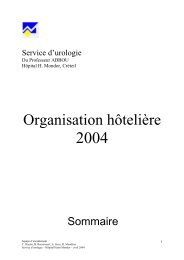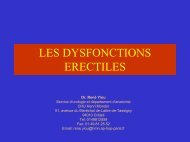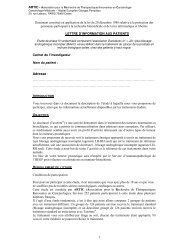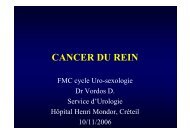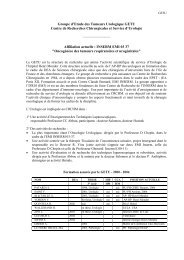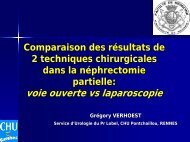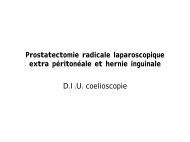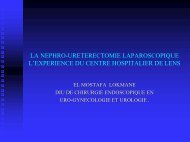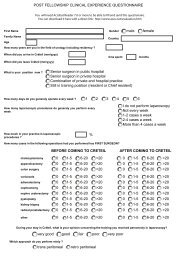Mutations FGFR3 et P53 dans le cancer de la vessie - Service d ...
Mutations FGFR3 et P53 dans le cancer de la vessie - Service d ...
Mutations FGFR3 et P53 dans le cancer de la vessie - Service d ...
- No tags were found...
Create successful ePaper yourself
Turn your PDF publications into a flip-book with our unique Google optimized e-Paper software.
HENRI MONDORLes mutations <strong>de</strong> <strong>FGFR3</strong> <strong>et</strong> <strong>de</strong> T<strong>P53</strong>définissent <strong>de</strong>ux voies molécu<strong>la</strong>iredistinctes <strong>dans</strong> <strong>le</strong> carcinome urothélialAshraf A. BAKKAR
Génétique <strong>de</strong>s UCC‣ OncogènesH-RAS - ERBB2 - CCND1 – MYC -<strong>FGFR3</strong> (40%)‣ Gènes suppresseurs <strong>de</strong> tumeursPTEN - RB - Altérations sur <strong>le</strong> chromosome 9(> 50% <strong>de</strong>s tumeurs <strong>de</strong> tout sta<strong>de</strong> <strong>et</strong> gra<strong>de</strong>)T<strong>P53</strong> (50-70% <strong>de</strong>s tumeurs invasives)
Schéma <strong>de</strong> <strong>la</strong> structure <strong>de</strong> <strong>la</strong> protéine <strong>FGFR3</strong>Pepti<strong>de</strong> SignalDomaineextracellu<strong>la</strong>ireDomaineIntracellu<strong>la</strong>ireIg IBoîte aci<strong>de</strong>Ig IIIg IIITransmembranaireTK 1TK2Épissage alternatif<strong>de</strong> <strong>la</strong> 2 ème partie dudomaine Ig IIIIsoforme III b<strong>dans</strong> <strong>le</strong>s cellu<strong>le</strong>s épithélia<strong>le</strong>sIsoforme III c<strong>dans</strong> <strong>le</strong>s chondrocytes
Mécanisme d’activation <strong>de</strong> <strong>FGFR3</strong> par <strong>le</strong>s mutationsExemp<strong>le</strong>s <strong>de</strong> mutations : R248C, S249C<strong>Mutations</strong>S-SR248C - S249C
<strong>FGFR3</strong>MUTATIONSRô<strong>le</strong> inhibiteur Oncogène ?Dysp<strong>la</strong>sie squel<strong>et</strong>tique(Germina<strong>le</strong>)UCC(Somatique)Ig IIg IIIg IIITMTK-1R248C TD I 24 (8.1%)S249C TD I 214 (71.8%)ABIsoform cG370/372C TD I 16 (5.4%)S371/373C TD I 0 (0%)Y373/375C TD I 30 (10.1%)G 375/377C ACH 0 (0%)G380/382R ACH 1 (0.3%)A391/393E C+AN 5 (1.7%)TK-2Dysp<strong>la</strong>sia Thanatophoric Type IDysp<strong>la</strong>sia Thanatophoric Type IIK650/652E TD II 4 (1.3%)K650/652M SADDAN 2 (0.7%)K650/652N,Q HCH 1 (0.3%)K650/652T ? 1 (0.3%)X807/809C,G,L,R,W TD I 0 (0%)N = 298 (100%)
La protéine p53‣ Est un facteur <strong>de</strong> transcription‣ Les fonctions majeures <strong>de</strong> p53 sont :- L’arrêt du cyc<strong>le</strong> cellu<strong>la</strong>ire- L’apoptose- La réparation <strong>de</strong> l ’ADN
Progression Tumora<strong>le</strong> <strong>de</strong>s UCCsHypothèse <strong>de</strong> travailDeux voies molécu<strong>la</strong>ires séparées interviendraient<strong>dans</strong> <strong>la</strong> progression <strong>de</strong>s UCC (1994)Altérations duChromosome 9Altérations<strong>de</strong> T<strong>P53</strong>Tumeurs papil<strong>la</strong>ires superficiel<strong>le</strong>sCarcinomes in situTumeurs invasives
UrothéliumNormal9-p539-Dysp<strong>la</strong>siePapil<strong>la</strong>irebas gra<strong>de</strong>Non-invasivep53Papil<strong>la</strong>irehaut gra<strong>de</strong>Non-invasiveTumeurs envahissantLamina PropriaTumeurs envahissant<strong>le</strong> musc<strong>le</strong>Métastases9-CarcinomeIn situprogression invasion
Étu<strong>de</strong> numéro 1Les mutations <strong>de</strong> <strong>FGFR3</strong> <strong>et</strong> T<strong>P53</strong>peuvent-el<strong>le</strong>s constituer <strong>de</strong>ux voies molécu<strong>la</strong>ires ?Les altérations du chromosome 9 sont aussi fréquentes <strong>dans</strong> <strong>le</strong>stumeurs <strong>de</strong> haut gra<strong>de</strong> <strong>et</strong> <strong>de</strong> haut sta<strong>de</strong> <strong>et</strong> ne peuvent êtreutilisées comme marqueurs spécifiques <strong>de</strong>s tumeurs papil<strong>la</strong>iresObjectifDémontrer que <strong>le</strong>s mutations <strong>de</strong> <strong>FGFR3</strong> <strong>et</strong> <strong>de</strong> T<strong>P53</strong>définissent bien <strong>de</strong>ux voies molécu<strong>la</strong>ires distinctes<strong>dans</strong> <strong>le</strong>s UCC au diagnostic initial
Métho<strong>de</strong>sAnalyses <strong>de</strong>s mutations <strong>de</strong> <strong>FGFR3</strong> <strong>et</strong> <strong>de</strong> T<strong>P53</strong>TumeursExtraction d’ ADNAmplification par PCRDépistage par DHPLCI<strong>de</strong>ntification <strong>de</strong>s mutations par séquencage
Profils d’élutions <strong>de</strong> <strong>la</strong> DHPLC d’ADN génomiquenormal <strong>et</strong> tumoral (<strong>FGFR3</strong> exon 7, T<strong>P53</strong> exon 6)<strong>FGFR3</strong>T<strong>P53</strong>mAU765ADN normalADN tumoralmAU7.5ADN normalADN tumoral435.0212.50-11 2 3 4 5 6Minutes0.0-0.95.0 5.5 6.0 6.5 7.0 7.5MinutesGTCC>TGC (S249C)CGA>CTA (R213K)
PATIENTS81 PATIENTS nombre <strong>de</strong> casSta<strong>de</strong> superficiel In situ 1pTa 31pT1 30invasif pT2 16pT3 2pT4 1Gra<strong>de</strong> G1 10G2 29G3 42
RésultatsLes mutations <strong>de</strong> <strong>FGFR3</strong> <strong>et</strong> <strong>de</strong> T<strong>P53</strong>selon <strong>le</strong> sta<strong>de</strong> <strong>et</strong> gra<strong>de</strong> <strong>de</strong>s UCCLes mutations <strong>de</strong> <strong>FGFR3</strong> <strong>et</strong> <strong>de</strong> T<strong>P53</strong> selon <strong>le</strong> sta<strong>de</strong>Les mutations <strong>de</strong> <strong>FGFR3</strong> <strong>et</strong> <strong>de</strong>T<strong>P53</strong> selon <strong>le</strong> gra<strong>de</strong>pourcentage <strong>de</strong>s mutations806040200pTan = 31p < 0.0001P < 0.003pT1n = 30pT2-T4n = 19<strong>FGFR3</strong>T<strong>P53</strong>pourcentage <strong>de</strong>s mutations80P < 0.008<strong>FGFR3</strong>P < 0.02 T<strong>P53</strong>6040200G1n = 10G2n = 29G3n = 42Les mutations <strong>de</strong> <strong>FGFR3</strong> sont associées aux tumeurs <strong>de</strong> bas sta<strong>de</strong> <strong>et</strong> <strong>de</strong> bas gra<strong>de</strong>Les mutations <strong>de</strong> T<strong>P53</strong> sont associées aux tumeurs <strong>de</strong> haut sta<strong>de</strong> <strong>et</strong> <strong>de</strong> haut gra<strong>de</strong>
RésultatsDistribution <strong>de</strong>s génotypes <strong>de</strong>s tumeurs selon <strong>le</strong> sta<strong>de</strong>pourcentage <strong>de</strong>s patients706050403020100Tan = 31T1n = 30T2-T4n = 19<strong>FGFR3</strong>mut/ T<strong>P53</strong>wt<strong>FGFR3</strong>wt /T<strong>P53</strong>wt<strong>FGFR3</strong>wt/ T<strong>P53</strong>mut.<strong>FGFR3</strong>mut./T<strong>P53</strong>mut.Les mutations <strong>de</strong> <strong>FGFR3</strong> <strong>et</strong> <strong>de</strong> T<strong>P53</strong> sont presquemutuel<strong>le</strong>ment exclusives
CONCLUSIONLes mutations <strong>de</strong> <strong>FGFR3</strong> <strong>et</strong> T<strong>P53</strong>définissent bien <strong>de</strong>ux voies molécu<strong>la</strong>iresdistinctes <strong>dans</strong> <strong>le</strong> développement <strong>de</strong>s UCC
Nous proposons un modè<strong>le</strong> <strong>de</strong> progression <strong>de</strong>s UCCsselon <strong>le</strong>s mutations <strong>de</strong> <strong>FGFR3</strong> <strong>et</strong> <strong>de</strong> T<strong>P53</strong>Bas gra<strong>de</strong>Ta<strong>FGFR3</strong> muté-9q ?Urothéliumnormal9 (-)T1≥T2T<strong>P53</strong> mutéTabacCISHaut gra<strong>de</strong>9 (-)



